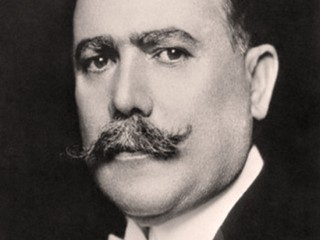
Alvaro Obregon biography
Date of birth : 1880-02-19
Date of death : 1928-07-17
Birthplace : Siquisiva, Navojoa, Sonora
Nationality : Mexican
Category : Politics
Last modified : 2010-11-22
Credited as : Politician, former President of Mexico, was assassinated in 1928
Álvaro Obregón was a Mexican revolutionary general and president. His administration marks the beginning of the constructive phase of the Mexican Revolution.
Anative of Sonora, born on Feb. 19, 1880, at Siquisava near Alamos, Alvaro Obregon was educated in his home state and was principally a small landholder when he first entered politics in 1911, winning election as municipal president of Huatabampo. The following year he recruited a small force to defend Francisco Madero's government against the Pascual Orozco rebellion. Promoted to the rank of colonel during this campaign, he was named military commander of the state capital, Hermosillo, in 1913.
That year Obregon organized resistance against Victoriano Huerta in Sonora, capturing Nogales on March 13, 1913. Venustiano Carranza designated him head of the war section of the Constitutionalists' Secretariat of the Interior and commander of the Northwest Army. While Pancho Villa moved southward in the central portion of the country, Obregon swept down the west coast, capturing Guadalajara and finally leading the triumphant Constitutionalist army into Mexico City in August 1914.
When a Revolutionary schism developed between Carranza and Villa,Obregon remained with the former in the withdrawal to Veracruz. There he negotiated the Constitutionalist agreement with labor and strongly urged Carranza to issue reform decrees relative to land and labor during the winter of 1914/1915. It was the military leadership of Obregon that gradually recovered the route to the capital and then dealt the villistas—a series of military reverses at Celaya and Leon in the spring of 1915. During one of these engagements Obregon lost an arm. And it was Obregon working behind the scenes who contributed significantly to the triumph of the radical elements in the Constituent Assembly at Queretaro in late 1916 and early 1917.
After briefly serving as secretary of war under Carranza, Obregon returned to private life as a chick-pea farmer until the presidential election of 1920. Together with Plutarco Calles and Adolfo de la Huerta, Obregon successfully revolted under the Plan of Agua Prieta (April 1920) against Carranza's efforts to impose his successor. During De la Huerta's provisional presidency Obregon was elected president for the 1920-1924 period.
It was a period of peace and constructive activity. For the first time the Revolution had a presidential regime committed to carrying out the program of the movement. The basic demands of the zapatistas were met and the first wide-scale distribution of land took place. Jose Vasconcelos directed an imaginative educational program, including volunteer teachers and cultural missions, and a cultural renaissance became dramatically visible with the mural painters. The interests of the favored labor group, led by Luis Morones, were protected.
However, the regime faced difficult times, threatened from without by United States intervention and from within by conservative and dissident Revolutionary elements. In 1923, by the Bucareli Agreement, United States recognition finally was achieved with an apparent settlement of the petroleum and land questions as well as an arrangement on claims. The development came none too soon, as rivalry for the presidential succession brought the De la Huerta rebellion (1923-1924). Support of peasants and workers plus the assistance of the neighbor to the north enabled the regime to triumph.
In 1927 the constitution was reformed to permit Obregon to again seek the presidency. Several abortive military revolts had to be put down, but Obregon was again victorious in the election of 1928. However, on August 17 the president-elect was killed in a restaurant in San Angel in the Federal District by a religious fanatic, Jose Leon Toral. It was ironic since Obregon had been quietly negotiating with Church leaders for a peaceful resolution of the Church-state conflict once he took office.
Although there are many significant writings on the Obregon period in Spanish by participants, English readers should turn first to contributions by two contemporaneous observers: Ernest Henry Groening, Mexico and Its Heritage (1928), and Frank Tannenbaum, Mexico: The Struggle for Peace and Bread (1956). A general review of the uprising, which includes a portrait of Obregon, is Ronald Atkin, Revolution! Mexico, 1910-20 (1970). For specific aspects of the period see Marjorie Ruth Clark, Organized Labor in Mexico (1934); Hubert Clinton Herring and Herbert Weinstock eds., Renascent Mexico (1935); and Robert E. Quirk, The Mexican Revolution, 1914-1915: The Convention of Aguascalientes (1970).
















